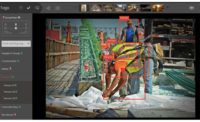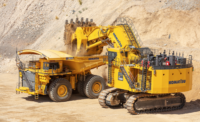The emergence of the COVID-19 pandemic in the U.S. and abroad in early 2020 caught many industries off guard, but in the perennial debate over the indoor air quality of commercial and public spaces, it supercharged a movement for cleaner air that was already gathering steam.
With manufacturers deploying a range of technologies, including MERV 13-rated HEPA filters, ultraviolet light, ionization, plasma arcs and hydrogen peroxide generators to neutralize, kill or filter the virus, it’s been a wild year that saw many of those resistant in the past to investing in improving air quality dragged forward by the necessity to do so.
“Early on in the pandemic, it was a bit of a Wild West,” says Tony Julian, vice president of business at RGF Environmental Group Inc., a manufacturer of air-treatment systems based in Palm Beach, Fla. The company is an established maker of several lines of water and air-treatment technologies, including HEPA (high-efficiency particulate absorbing) filters and UV-activated airborne hydrogen-peroxide systems.
According to Julian, when COVID-19 first began to shut down travel and business in the U.S. in 2020, one of the worst bottlenecks was in scheduling third-party testing labs to evaluate equipment for effectiveness against the virus. “At that time, early in the pandemic, it was hard to access test facilities. A lot of companies couldn’t get into labs,” he says.
This led to a bit of a delay in RGF and other manufacturers getting their systems tested against coronavirus or coronavirus-equivalent viruses, and there is still a backlog at qualified labs in testing air-treatment systems for their effectiveness against the virus, according to several manufacturers contacted by ENR.
The airborne transmission vector for COVID-19 was a point of contention among medical professionals in 2020 as the virus spread, and it was only after much debate that groups such as the Centers for Disease Control and Prevention and the World Health Organization acknowledged the spread of COVID-19 via aerosols, as opposed to guidance just around contaminated surfaces or slow-falling airborne droplets.
On April 5, the American Society of Heating, Refrigerating and Air-Conditioning Engineers updated its guidance on the known vectors of COVID-19, saying “Airborne transmission of SARS-CoV-2 is significant and should be controlled.”
This is a shift from ASHRAE’s language in an earlier statement in April 2020 that airborne transmission of COVID-19 was “sufficiently likely.” The new guidance further adds that “changes to building operations, including the operation of heating, ventilating, and air-conditioning systems, can reduce airborne exposures.”
“There is no one-size-fits-all clean-air solution, because every building and environment is different.”
—Mark Mattingly, Vice President and General Manager, Johnson Controls
William P. Bahnfleth, ASHRAE Epidemic Task Force chair, said in the release, “This may seem like a small step, but we feel it is important to leave no doubt about our position, given the muted support for ventilation and filtration as important tools in the effort to stop the pandemic, from some organizations that should be leading more strongly.”
Making indoor air “safe” from COVID-19 has been a fraught topic in the air-handling world. Even exemplary systems that can achieve near 100% effectiveness at removing or deactivating the virus in testing still come with caveats that some risk remains.
The Biodefense Indoor Air Protection Filter—developed by Monzer Hourani and his firm Integrated Viral Protection in 2020 in response to the pandemic—has been shown to reduce COVID-19 viruses by 99.999% in lab tests, but such devices are just beginning to see wider use.
In some cases, manufacturers with existing air-treatment or filtration technology that were already fairly effective against COVID-19 are now pitching their products as part of a more comprehensive approach.
“There is no one-size-fits-all clean-air solution because every building and environment is different,” says Mark Mattingly, vice president and general manager, air filtration products, at Johnson Controls. “Our clean air strategies begin with air flow, ventilation and filtration, which are often the most efficient solutions.”
While proper use of outdoor air ventilation according to ASHRAE 62.1 can do a great deal of work in removing virus particles from the air, Mattingly says these practices can be further supplemented with other technologies, such as the company’s portable IsoClean CM standalone HEPA air filters.
Johnson Controls initially had an IsoClean CM unit that could handle 800 cu ft per minute, but early in the pandemic it found there was demand for a smaller 400-cfm unit, and it later developed a 1,700-cfm unit for larger spaces. Independent testing at the University of Wisconsin-Madison found the IsoClean 800 achieved particle reduction in the air equivalent to an outdoor airflow of 800 cfm. But these powerful filters are still just mitigation measures, not complete solutions. “There is no accepted definition of COVID ‘safe,’ ” notes Mattingly.
Even the makers of more aggressive, active-treatment air systems should be careful about how they describe their effectiveness, cautions RGF’s Julian. “[Our] process is very effective, in third-party testing we always exceed 99% [virus elimination]. But this is a supplemental product—we don’t make claims it is a complete replacement for surface cleaning, masking or social distancing to control COVID.”
James Marsden, executive director for science and technology at RGF, explains how the principle behind RGF’s hydrogen peroxide technology, the PHI-CELL, is room-temperature plasma that generates hydrogen peroxide molecules in the air to attack and neutralize pathogens. The technology behind this is decades old, and Marsden says it is an effective way to attack viruses such as COVID-19.
“We know today [COVID-19] is spread in the air, and 80% of transmission is in particles less than one micron in size, which can stay suspended for a long time,” he explains. “What RGF offers is an active air-treatment process: We have hydrogen peroxide particles that are projected into the spaces and will activate on contact [with the virus]. We have technology that doesn’t replace air filtration, but it adds a whole different dimension to our ability to control viruses.” The amount of hydrogen peroxide found in the air treated by the RGF system is about 0.02 ppm, comparable to normal ambient outdoor levels.
Marsden first encountered RGF’s system when he was a professor of meat science at Kansas State University, working on a research project at Sandia National Lab. He would later recommend the system in 2015 when he was brought in to help Chipotle control outbreaks of norovirus that were plaguing its stores. “We took this technology to Chipotle, showed it to them, and they ended up using it in 2,600 restaurants—in the HVAC, the restrooms, the ice machines,” recalls Marsden. “It did an excellent job stopping norovirus outbreaks at Chipotle.” He left Chipotle last year, and has been advising RGF since.
When the pandemic began, Marsden thought these existing RGF devices could also be effective on COVID-19, and found a lab that would be able to perform live testing with actual SARS-CoV-2 virus. RGF’s device was able to achieve 99.9% reduction in virus particles. Subsequent testing with both surface and air samplers found the device performed even better. “We got almost a 5-log reduction—99.99% reduction in air—with reduction beginning immediately on contact,” says Marsden. “Within 45 minutes we brought the virus down to the detection limit.” He is now working with the EPA to test the RGF devices in an even larger space with full HVAC systems.
Some of the manufacturers tackling pandemic air-treatment aren’t even originally from the buildings sector. Plasma-based air-treatment maker APJeT had previously focused on systems to kill and remove pathogens and other unwanted microorganism from non-woven textiles and other durable goods. The company’s system uses a series of coils that generate room-temperature plasma that can deactivate viruses and kill microorganisms in air forced over it by a fan.
“We send air through plasma, it energizes the air, creating this energy-rich gas state that is able to react with the virus and bacteria that pass through it and deactivate them,” says April Wilburn, applications development manager at APJeT. Before the pandemic, APJeT had looked at new uses for plasma as a disinfectant, but mostly had focused on safer ways to clean fresh fruit and vegetables. “When the pandemic hit, we came together and had a brainstorming session,” says Wilburn. “We had this unique technology here, and there was evidence it would be able to kill viruses. This is a new application for us, but we saw an opportunity where our technology could be used to help people.”
The APJeT system is available as the standalone “Covidinator” with a built-in fan to blow air across the plasma-generating unit, and it is able to handle 60 cfm of airflow. Early customers have included airlines and private jet operators that want to disinfect their planes in-between flights, but Wilburn says the company is also working on units that can be fitted directly into HVAC systems.
“This is a new application for us, but we saw an opportunity where our technology could be used to help people.”
—April Wilburn, Applications Development Manager, Apjet
Not all technologies attacking COVID-19 aim to actively destroy the virus.
AtmosAir specializes in bipolar ionization, where free radicals are generated in an air-handling system, which then attach to viruses and other particles, agglomerating and weighing them down so they fall out of the air. Already seeing new use in HVAC systems in office buildings and cruise ships, the company’s system has been shown to reduce COVID particles by over 99.9% in independent testing.
With guidance from the government and industry associations somewhat limited in 2020, and commercial real estate hemorrhaging tenants during prolonged shutdowns, some building owners took matters into their own hands.
New York City-based real estate management firm Fisher Brothers had already completed an extensive evaluation of air-treatment and filtration technologies that could be used to retrofit its office buildings in Manhattan, where it has over 6 million sq ft of commercial space.
“Originally this was being done just for the air quality alone for our tenants,” says Kenneth Fisher, co-managing partner at Fisher Brothers. “But as the pandemic hit, we had already started to deploy this technology.”
In addition to complying with new practices around social distancing, mask-wearing and temperature checks, he saw a chance to speed the deployment of the air-treatment technology, in this case the hydrogen-peroxide generating system from RGF, which his advisors Clean Science Solutions had selected after reviewing other available technologies.
“It was four years ago that Ken had wanted to address this [indoor air quality] issue,” says Thomas Misisco, CEO and co-founder of Clean Science Solutions. “We did about 18 months of testing in one of his buildings, and we decided that the [PHI-CELL] was the best technology.” Misisco founded Clean Science shortly after this test phase with his colleague Billy Ward, and they now offer services to both assess building air quality and install systems such as the RGF technology, of which they are a reseller.
During the pandemic, Clean Science oversawinstallation of the RGF system into the HVAC system of one of Fisher Bros.’ buildings in New York City, 1345 Ave. of the Americas, which has over 1 million sq ft of space. But in late 2020, a tenant there asked Fisher if it could also start moving some staff back into a location at another Fisher property, 299 Park Ave.
“When 299 wanted to open, we had placed two orders with RGF, and we knew we could get it done, but the shipping would come in late,” says Misisco. “It was a very important client, so we took matters into our own hands.” Misisco and Ward flew down to the RGF facility in Florida and drove a truck with the air-treatment units back to New York City themselves so they could install the devices in time for the deadline.
With many companies now considering making work-from-home a permanent option, Fisher says building owners should refocus on data-driven methods to show they are taking air-quality and safety issues seriously. “In the beginning everyone was running around kind of blind. But now with air filtration, it’s about having the data that shows we’ve got a 99.99% kill rate on the virus.”














Post a comment to this article
Report Abusive Comment